Preparation and Application of Carbon Dots Nanozymes
Abstract
1. Introduction
2. Preparation of CDs Nanozymes
2.1. Hydrothermal Synthesis
2.2. Microwave Radiation Method
3. Applications of CDs Nanozymes
3.1. Single-Atom Nanozymes
3.2. Nonmetal-Doped CD Nanozymes
3.3. Metal-Doped CDs Nanozymes
3.4. Codoped CD Nanozymes
3.5. Undoped CD Nanozymes
4. Summary and Prospects
Author Contributions
Funding
Institutional Review Board Statement
Informed Consent Statement
Data Availability Statement
Conflicts of Interest
References
- Sun, H.; Zhou, Y.; Ren, J.; Qu, X. Carbon Nanozymes: Enzymatic Properties, Catalytic Mechanism, and Applications. Angew. Chem. Int. Ed. 2018, 57, 9224–9237. [Google Scholar] [CrossRef] [PubMed]
- Yu, Z.; Lou, R.; Pan, W.; Li, N.; Tang, B. Nanoenzymes in Disease Diagnosis and Therapy. Chem. Commun. 2020, 56, 15513–15524. [Google Scholar] [CrossRef]
- Wang, M.; Zhu, P.; Liu, S.; Chen, Y.; Liang, D.; Liu, Y.; Chen, W.; Du, L.; Wu, C. Application of Nanozymes in Environmental Monitoring, Management, and Protection. Biosensors 2023, 13, 314. [Google Scholar] [CrossRef]
- Chen, X.; Liao, J.; Lin, Y.; Zhang, J.; Zheng, C. Nanozyme’s Catalytic Activity at Neutral pH: Reaction Substrates and Application in Sensing. Anal. Bioanal. Chem. 2023, 415, 3817–3830. [Google Scholar] [CrossRef]
- Zhang, X.; Chen, X.; Zhao, Y. Nanozymes: Versatile Platforms for Cancer Diagnosis and Therapy. Nano Micro Lett. 2022, 14, 95. [Google Scholar] [CrossRef]
- Zhang, L.; Wang, H.; Qu, X. Biosystem-Inspired Engineering of Nanozymes for Biomedical Applications. Adv. Mater. 2023, 36, 2211147. [Google Scholar] [CrossRef] [PubMed]
- Li, P.; Wu, C.; Xu, Y.; Cheng, D.; Lu, Q.; Gao, J.; Yang, W.; Zhu, X.; Liu, M.; Li, H.; et al. Group IV Nanodots: Newly Emerging Properties and Application in Biomarkers Sensing. TrAC Trends Anal. Chem. 2020, 131, 116007. [Google Scholar] [CrossRef]
- Jin, J.; Li, L.; Zhang, L.; Luan, Z.; Xin, S.; Song, K. Progress in the Application of Carbon Dots-Based Nanozymes. Front. Chem. 2021, 9, 748044. [Google Scholar] [CrossRef] [PubMed]
- He, D.; Yan, M.; Sun, P.; Sun, Y.; Qu, L.; Li, Z. Recent Progress in Carbon-Dots-Based Nanozymes for Chemosensing and Biomedical Applications. Chin. Chem. Lett. 2021, 32, 2994–3006. [Google Scholar] [CrossRef]
- Xu, Y.; Zhou, Z.; Deng, N.; Fu, K.; Zhu, C.; Hong, Q.; Shen, Y.; Liu, S.; Zhang, Y. Molecular Insights of Nanozymes from Design to Catalytic Mechanism. Sci. China Chem. 2023, 66, 1318–1335. [Google Scholar] [CrossRef]
- Shamsabadi, A.; Haghighi, T.; Carvalho, S.; Frenette, L.C.C.; Stevens, M.M.M. The Nanozyme Revolution: Enhancing the Performance of Medical Biosensing Platforms. Adv. Mater. 2023, 36, 2300184. [Google Scholar] [CrossRef] [PubMed]
- Wu, Y.; Darland, D.C.; Zhao, J.X. Nanozymes-Hitting the Biosensing “Target”. Sensors 2021, 21, 5201. [Google Scholar] [CrossRef] [PubMed]
- Ding, H.; Hu, B.; Zhang, B.; Zhang, H.; Yan, X.; Nie, G.; Liang, M. Carbon-Based Nanozymes for Biomedical Applications. Nano Res. 2021, 14, 570–583. [Google Scholar] [CrossRef]
- Yang, W.; Yang, X.; Zhu, L.; Chu, H.; Li, X.; Xu, W. Nanozymes: Activity Origin, Catalytic Mechanism, and Biological Application. Coord. Chem. Rev. 2021, 448, 214170. [Google Scholar] [CrossRef]
- Wang, X.; Hu, Y.; Wei, H. Nanozymes in Bionanotechnology: From Sensing to Therapeutics and Beyond. Inorg. Chem. Front. 2016, 3, 41–60. [Google Scholar] [CrossRef]
- Liu, H.; Zhong, X.; Pan, Q.; Zhang, Y.; Deng, W.; Zou, G.; Hou, H.; Ji, X. A Review of Carbon Dots in Synthesis Strategy. Coordin. Chem. Rev. 2024, 498, 215468. [Google Scholar] [CrossRef]
- Jiang, J.; Li, X.; Li, H.; Lv, X.; Xu, Y.; Hu, Y.; Song, Y.; Shao, J.; Li, S.; Yang, D. Recent Progress in Nanozymes for the Treatment of Diabetic Wounds. J. Mat. Chem. B 2023, 11, 6746–6761. [Google Scholar] [CrossRef] [PubMed]
- Cai, Y.; Li, Y.; Zhang, J.; Tang, N.; Bao, X.; Liu, Z. New Horizons for Therapeutic Applications of Nanozymes in Oral Infection. Particuology 2023, 80, 61–73. [Google Scholar] [CrossRef]
- Chakraborty, N.; Gandhi, S.; Verma, R.; Roy, I. Emerging Prospects of Nanozymes for Antibacterial and Anticancer Applications. Biomedicines 2022, 10, 1378. [Google Scholar] [CrossRef]
- Cong, W.; Meng, L.; Pan, Y.; Wang, H.; Zhu, J.; Huang, Y.; Huang, Q. Mitochondrial-Mimicking Nanozyme-Catalyzed Cascade Reactions for Aging Attenuation. Nano. Today 2023, 48, 101757. [Google Scholar] [CrossRef]
- Wang, F.; Wang, Y.; Wang, H.; Zhao, G.; Li, J.; Wang, Y. Advances in the Application of Single-Atom Nanozymes for Heavy Metal Ion Detection, Tumor Therapy and Antimicrobial Therapy. Microchem. J. 2023, 191, 108817. [Google Scholar] [CrossRef]
- Ren, X.; Liu, J.; Ren, J.; Tang, F.; Meng, X. One-Pot Synthesis of Active Copper-Containing Carbon Dots with Laccase-like Activities. Nanoscale 2015, 7, 19641–19646. [Google Scholar] [CrossRef] [PubMed]
- Zhang, J.; Wu, S.; Lu, X.; Wu, P.; Liu, J. Manganese as a Catalytic Mediator for Photo-Oxidation and Breaking the pH Limitation of Nanozymes. Nano Lett. 2019, 19, 3214–3220. [Google Scholar] [CrossRef] [PubMed]
- Ju, Y.; Liu, X.; Ye, X.; Dai, M.; Fang, B.; Shen, X.; Liu, L. Nanozyme-Based Remodeling of Disease Microenvironments for Disease Prevention and Treatment: A Review. ACS Appl. Nano Mater. 2023, 6, 13792–13823. [Google Scholar] [CrossRef]
- Farshidfar, N.; Fooladi, S.; Nematollahi, M.H.; Iravani, S. Carbon Dots with Tissue Engineering and Regenerative Medicine Applications. RSC Adv. 2023, 13, 14517–14529. [Google Scholar] [CrossRef] [PubMed]
- Tu, L.; Li, Q.; Qiu, S.; Li, M.; Shin, J.; Wu, P.; Singh, N.; Li, J.; Ding, Q.; Hu, C.; et al. Recent Developments in Carbon Dots: A Biomedical Application Perspective. J. Mat. Chem. B 2023, 11, 3038–3053. [Google Scholar] [CrossRef]
- Alafeef, M.; Srivastava, I.; Aditya, T.; Pan, D. Carbon Dots: From Synthesis to Unraveling the Fluorescence Mechanism. Small 2023, 20, 2303937. [Google Scholar] [CrossRef] [PubMed]
- Szczepankowska, J.; Khachatryan, G.; Khachatryan, K.; Krystyjan, M. Carbon Dots—Types, Obtaining and Application in Biotechnology and Food Technology. Int. J. Mol. Sci. 2023, 24, 14984. [Google Scholar] [CrossRef] [PubMed]
- Jorns, M.; Pappas, D. A Review of Fluorescent Carbon Dots, Their Synthesis, Physical and Chemical Characteristics, and Applications. Nanomaterials 2021, 11, 1448. [Google Scholar] [CrossRef] [PubMed]
- Adeola, A.O.; Clermont-Paquette, A.; Piekny, A.; Naccache, R. Advances in the Design and Use of Carbon Dots for Analytical and Biomedical Applications. Nanotechnology 2024, 35, 012001. [Google Scholar] [CrossRef]
- Khayal, A.; Dawane, V.; Amin, M.A.; Tirth, V.; Yadav, V.K.; Algahtani, A.; Khan, S.H.; Islam, S.; Yadav, K.K.; Jeon, B.-H. Advances in the Methods for the Synthesis of Carbon Dots and Their Emerging Applications. Polymers 2021, 13, 3190. [Google Scholar] [CrossRef] [PubMed]
- Qu, D.; Wang, X.; Bao, Y.; Sun, Z. Recent Advance of Carbon Dots in Bio-Related Applications. J. Phys. Mater. 2020, 3, 022003. [Google Scholar] [CrossRef]
- Qu, D.; Sun, Z. The Formation Mechanism and Fluorophores of Carbon Dots Synthesized via a Bottom-up Route. Mat. Chem. Front. 2020, 4, 400–420. [Google Scholar] [CrossRef]
- Kotta, S.; Aldawsari, H.M.; Badr-Eldin, S.M.; Alhakamy, N.A.; Md, S.; Nair, A.B.; Deb, P.K. Exploring the Potential of Carbon Dots to Combat COVID-19. Front. Mol. Biosci. 2020, 7, 616575. [Google Scholar] [CrossRef]
- Fang, M.; Wang, B.; Qu, X.; Li, S.; Huang, J.; Li, J.; Lu, S.; Zhou, N. State-of-the-Art of Biomass-Derived Carbon Dots: Preparation, Properties, and Applications. Chin. Chem. Lett. 2024, 35, 108423. [Google Scholar] [CrossRef]
- Liu, C.; Fan, W.; Cheng, W.; Gu, Y.; Chen, Y.; Zhou, W.; Yu, X.; Chen, M.; Zhu, M.; Fan, K.; et al. Red Emissive Carbon Dot Superoxide Dismutase Nanozyme for Bioimaging and Ameliorating Acute Lung Injury. Adv. Funct. Mater. 2023, 33, 2213856. [Google Scholar] [CrossRef]
- Loukanov, A.; Chichova, M.; Filipov, C.; Shkodrova, M.; Mishonova, M.; Mladenova, K.; Doumanov, J.; Gagov, H. Photo-Oxidase Carbon Dot-Based Nanozyme for Breast Cancer Theranostics under Normoxia Condition. J. Photochem. Photobiol. A Chem. 2023, 439, 114632. [Google Scholar] [CrossRef]
- Pan, T.; Chen, H.; Gao, X.; Wu, Z.; Ye, Y.; Shen, Y. Engineering Efficient Artificial Nanozyme Based on Chitosan Grafted Fe-Doped-Carbon Dots for Bacteria Biofilm Eradication. J. Hazard. Mater. 2022, 435, 128996. [Google Scholar] [CrossRef] [PubMed]
- Yin, Q.; Yang, X.; Yang, L.; Yang, D.; Yang, Y.; Zhu, Y. Cu, I-Doped Carbon Dots as Simulated Nanozymes for the Colorimetric Detection of Morphine in Biological Samples. Anal. Biochem. 2023, 680, 115313. [Google Scholar] [CrossRef]
- Gao, W.; He, J.; Chen, L.; Meng, X.; Ma, Y.; Cheng, L.; Tu, K.; Gao, X.; Liu, C.; Zhang, M.; et al. Deciphering the Catalytic Mechanism of Superoxide Dismutase Activity of Carbon Dot Nanozyme. Nat. Commun. 2023, 14, 160. [Google Scholar] [CrossRef]
- Shen, Y.; Zhang, R.; Wang, Y. One-Pot Hydrothermal Synthesis of Metal-Doped Carbon Dot Nanozymes Using Protein Cages as Precursors. RSC Adv. 2023, 13, 6760–6767. [Google Scholar] [CrossRef] [PubMed]
- Zandieh, M.; Liu, J. Nanozymes: Definition, Activity, and Mechanisms. Adv. Mater. 2023, 36, 2211041. [Google Scholar] [CrossRef]
- Pei, J.; Zhao, R.; Mu, X.; Wang, J.; Liu, C.; Zhang, X.-D. Single-Atom Nanozymes for Biological Applications. Biomater. Sci. 2020, 8, 6428–6441. [Google Scholar] [CrossRef] [PubMed]
- Wu, X.; Zhang, R.; Yan, X.; Fan, K. Nanozyme: A New Approach for Anti-Microbial Infections. J. Inorg. Mater. 2023, 38, 43–54. [Google Scholar] [CrossRef]
- Wang, X.; Lu, Y.; Hua, K.; Yang, D.; Yang, Y. Iodine-Doped Carbon Dots with Inherent Peroxidase Catalytic Activity for Photocatalytic Antibacterial and Wound Disinfection. Anal. Bioanal. Chem. 2021, 413, 1373–1382. [Google Scholar] [CrossRef] [PubMed]
- Ahmadi, S.; Rahimizadeh, K.; Shafiee, A.; Rabiee, N.; Iravani, S. Nanozymes and Their Emerging Applications in Biomedicine. Process. Biochem. 2023, 131, 154–174. [Google Scholar] [CrossRef]
- Xu, S.; Zhang, S.; Li, Y.; Liu, J. Facile Synthesis of Iron and Nitrogen Co-Doped Carbon Dot Nanozyme as Highly Efficient Peroxidase Mimics for Visualized Detection of Metabolites. Molecules 2023, 28, 6064. [Google Scholar] [CrossRef] [PubMed]
- Zhao, D.; Liu, H.; Zhang, C.; Xiao, X.; He, Z. UV-Induced Oxidase Activity of Carbon Dots in Visible UVA Dosage, Escherichia Coli Quantification and Bacterial Typing. Anal. Chim. Acta 2024, 1288, 342140. [Google Scholar] [CrossRef] [PubMed]
- Huang, Y.; Ding, Z.; Li, Y.; Xi, F.; Liu, J. Magnetic Nanozyme Based on Loading Nitrogen-Doped Carbon Dots on Mesoporous Fe3O4 Nanoparticles for the Colorimetric Detection of Glucose. Molecules 2023, 28, 4573. [Google Scholar] [CrossRef]
- Yang, D.; Li, Q.; Zhang, Q.; Wang, Y.; Li, H.; Tammina, S.K.; Yang, Y. A Multifunctional Nanozyme-Based Enhanced System for Tert-Butyl Hydroquinone Assay by Surface-Enhanced Raman Scattering. Microchim. Acta 2022, 189, 29. [Google Scholar] [CrossRef]
- Bandi, R.; Alle, M.; Park, C.-W.; Han, S.-Y.; Kwon, G.-J.; Kim, N.-H.; Kim, J.-C.; Lee, S.-H. Cellulose Nanofibrils/Carbon Dots Composite Nanopapers for the Smartphone-Based Colorimetric Detection of Hydrogen Peroxide and Glucose. Sens. Actuator B Chem. 2021, 330, 129330. [Google Scholar] [CrossRef]
- Li, L.; Wang, D.; Ren, L.; Wang, T.; Tan, X.; Cui, F.; Li, T.; Li, J. Chitosan-Chelated Carbon Dots-Based Nanozyme of Extreme Stability with Super Peroxidase Activity and Antibacterial Ability for Wound Healing. Int. J. Biol. Macromol. 2024, 258, 129098. [Google Scholar] [CrossRef] [PubMed]
- Gao, X.; Wang, L.; Sun, C.; Zhou, N. Research on Preparation Methods of Carbon Nanomaterials Based on Self-Assembly of Carbon Quantum Dots. Molecules 2022, 27, 1690. [Google Scholar] [CrossRef] [PubMed]
- Zhao, X.-X.; Tao, S.-Y.; Yang, B. The Classification of Carbon Dots and the Relationship between Synthesis Methods and Properties. Chin. J. Chem. 2023, 41, 2206–2216. [Google Scholar] [CrossRef]
- Cui, L.; Ren, X.; Sun, M.; Liu, H.; Xia, L. Carbon Dots: Synthesis, Properties and Applications. Nanomaterials 2021, 11, 3419. [Google Scholar] [CrossRef]
- Xia, C.; Zhu, S.; Feng, T.; Yang, M.; Yang, B. Evolution and Synthesis of Carbon Dots: From Carbon Dots to Carbonized Polymer Dots. Adv. Sci. 2019, 6, 1901316. [Google Scholar] [CrossRef] [PubMed]
- Zhang, Z.; Yi, G.; Li, P.; Zhang, X.; Fan, H.; Zhang, Y.; Wang, X.; Zhang, C. A Minireview on Doped Carbon Dots for Photocatalytic and Electrocatalytic Applications. Nanoscale 2020, 12, 13899–13906. [Google Scholar] [CrossRef]
- Ross, S.; Wu, R.-S.; Wei, S.-C.; Ross, G.M.; Chang, H.-T. The Analytical and Biomedical Applications of Carbon Dots and Their Future Theranostic Potential: A Review. J. Food Drug Anal. 2020, 28, 677–695. [Google Scholar] [CrossRef]
- Ehtesabi, H.; Hallaji, Z.; Najafi Nobar, S.; Bagheri, Z. Carbon Dots with pH-Responsive Fluorescence: A Review on Synthesis and Cell Biological Applications. Microchim. Acta 2020, 187, 150. [Google Scholar] [CrossRef]
- Fu, Q.; Zhang, K.; Lu, K.; Li, N.; Sun, S.; Dong, Z. Recent Advances in Solid-State Fluorescent of Red Carbon Dots: A Comprehensive Review. J. Alloy Compd. 2024, 971, 172688. [Google Scholar] [CrossRef]
- Koutsogiannis, P.; Thomou, E.; Stamatis, H.; Gournis, D.; Rudolf, P. Advances in Fluorescent Carbon Dots for Biomedical Applications. Adv. Phys. X 2020, 5, 1758592. [Google Scholar] [CrossRef]
- Zhang, J.; Lin, Y.; Wu, S.; Hou, X.; Zheng, C.; Wu, P.; Liu, J. Self-Photo-Oxidation for Extending Visible Light Absorption of Carbon Dots and Oxidase-like Activity. Carbon 2021, 182, 537–544. [Google Scholar] [CrossRef]
- Li, P. The Valine-based N-doped Carbon Dots with High Peroxidase-like Activity. Luminescence 2022, 37, 1725–1732. [Google Scholar] [CrossRef]
- Lee, A.; Yun, S.; Kang, E.S.; Kim, J.W.; Park, J.H.; Choi, J. Effect of Heteroatoms on the Optical Properties and Enzymatic Activity of N-Doped Carbon Dots. RSC Adv. 2021, 11, 18776–18782. [Google Scholar] [CrossRef]
- Wang, H.; Wang, Q.; Wang, Q.; Dong, W.; Liu, Y.; Hu, Q.; Song, X.; Shuang, S.; Dong, C.; Gong, X. Metal-Free Nitrogen-Doped Carbon Nanodots as an Artificial Nanozyme for Enhanced Antibacterial Activity. J. Clean. Prod. 2023, 411, 137337. [Google Scholar] [CrossRef]
- Wang, H.; Zhang, M.; Wei, K.; Zhao, Y.; Nie, H.; Ma, Y.; Zhou, Y.; Huang, H.; Liu, Y.; Shao, M.; et al. Pyrrolic Nitrogen Dominated the Carbon Dot Mimic Oxidase Activity. Carbon 2021, 179, 692–700. [Google Scholar] [CrossRef]
- Liu, Y.; Xu, B.; Lu, M.; Li, S.; Guo, J.; Chen, F.; Xiong, X.; Yin, Z.; Liu, H.; Zhou, D. Ultrasmall Fe-Doped Carbon Dots Nanozymes for Photoenhanced Antibacterial Therapy and Wound Healing. Bioact. Mater. 2022, 12, 246–256. [Google Scholar] [CrossRef] [PubMed]
- Zhuo, S.; Fang, J.; Li, M.; Wang, J.; Zhu, C.; Du, J. Manganese(II)-Doped Carbon Dots as Effective Oxidase Mimics for Sensitive Colorimetric Determination of Ascorbic Acid. Microchim. Acta 2019, 186, 745. [Google Scholar] [CrossRef] [PubMed]
- Lu, W.; Guo, Y.; Zhang, J.; Yue, Y.; Fan, L.; Li, F.; Dong, C.; Shuang, S. A High Catalytic Activity Nanozyme Based on Cobalt-Doped Carbon Dots for Biosensor and Anticancer Cell Effect. ACS Appl. Mater. Interfaces 2022, 14, 57206–57214. [Google Scholar] [CrossRef]
- Lu, W.; Guo, Y.; Yue, Y.; Zhang, J.; Fan, L.; Li, F.; Zhao, Y.; Dong, C.; Shuang, S. Smartphone-Assisted Colorimetric Sensing Platform Based on Molybdenum-Doped Carbon Dots Nanozyme for Visual Monitoring of Ampicillin. Chem. Eng. J. 2023, 468, 143615. [Google Scholar] [CrossRef]
- Zhao, L.; Wu, Z.; Liu, G.; Lu, H.; Gao, Y.; Liu, F.; Wang, C.; Cui, J.; Lu, G. High-Activity Mo, S Co-Doped Carbon Quantum Dot Nanozyme-Based Cascade Colorimetric Biosensor for Sensitive Detection of Cholesterol. J. Mat. Chem. B 2019, 7, 7042–7051. [Google Scholar] [CrossRef] [PubMed]
- Zhao, N.; Song, J.; Zhao, L. Metallic Deep Eutectic Solvents-Assisted Synthesis of Cu, Cl-Doped Carbon Dots as Oxidase-like and Peroxidase-like Nanozyme for Colorimetric Assay of Hydroquinone and H2O2. Colloid Surf. S Physicochem. Eng. Asp. 2022, 648, 129390. [Google Scholar] [CrossRef]
- Li, X.; Xu, Y.; Ouyang, D.; Ye, K.; Chen, Y.; Li, Q.; Xia, Q.; Wu, X.; Yang, Y. Copper- and Iodine-Doped Nanozymes with Simulated Enzyme Activity and Efficient Antifungal Activity against Candida Albicans. Biochem. Eng. J. 2023, 191, 108791. [Google Scholar] [CrossRef]
- Li, X.; Wu, X.; Yuan, T.; Zhu, J.; Yang, Y. Influence of the Iodine Content of Nitrogen- and Iodine-Doped Carbon Dots as a Peroxidase Mimetic Nanozyme Exhibiting Antifungal Activity against C. Albicans. Biochem. Eng. J. 2021, 175, 108139. [Google Scholar] [CrossRef]
- Alqahtani, Y.S.; Mahmoud, A.M.; El-Wekil, M.M. Bifunctional Nanoprobe for Dual-Mode Detection Based on Blue Emissive Iron and Nitrogen Co-Doped Carbon Dots as a Peroxidase-Mimic Platform. Talanta 2023, 253, 124024. [Google Scholar] [CrossRef]
- Wang, L.; Liu, Y.; Yang, Z.; Wang, Y.; Rao, H.; Yue, G.; Wu, C.; Lu, C.; Wang, X. A Ratiometric Fluorescence and Colorimetric Dual-Mode Assay for H2O2 and Xanthine Based on Fe, N Co-Doped Carbon Dots. Dyes Pigments 2020, 180, 108486. [Google Scholar] [CrossRef]
- Su, L.; Qin, S.; Cai, Y.; Wang, L.; Dong, W.; Mao, G.; Feng, S.; Xie, Z.; Zhang, H. Co, N-Doped Carbon Dot Nanozymes with Acid pH-Independence and Substrate Selectivity for Biosensing and Bioimaging. Sens. Actuators B Chem. 2022, 353, 131150. [Google Scholar] [CrossRef]
- Dong, W.; Xu, L.; Chen, M.; Jiang, T.; Su, L.; Ma, J.; Chen, C.; Zhang, G. Co-, N-Doped Carbon Dot Nanozymes Based on an Untriggered ROS Generation Approach for Anti-Biofilm Activities and In Vivo Anti-Bacterial Treatment. J. Mater. Chem. B 2024, 12, 1052–1063. [Google Scholar] [CrossRef] [PubMed]
- Ahmad, H.A.; Hassan, R.O. Newly Synthesized Fe-Doped CDs for Colorimetric and Fluorometric Nanozyme-Based Levodopa Sensing. Luminescence 2023, 38, 437–449. [Google Scholar] [CrossRef]
- Muhammad, P.; Hanif, S.; Li, J.; Guller, A.; Rehman, F.U.; Ismail, M.; Zhang, D.; Yan, X.; Fan, K.; Shi, B. Carbon Dots Supported Single Fe Atom Nanozyme for Drug-Resistant Glioblastoma Therapy by Activating Autophagy-Lysosome Pathway. Nano Today 2022, 45, 101530. [Google Scholar] [CrossRef]
- Bijalwan, K.; Kumari, A.; Kaushal, N.; Indra, A.; Saha, A. Solid-State Synthesis of Cu Doped CDs with Peroxidase-Mimicking Activity at Neutral pH and Sensing of Antioxidants. ChemNanoMat 2022, 8, e202200044. [Google Scholar] [CrossRef]
- Kaushal, N.; Jain, A.; Kumar, A.; Sarraf, S.; Basu, A.K.; Raje, C.I.; Saha, A. Solvent-Free Synthesis of S,N-Doped Carbon Dots for Extended Visible-Light-Induced Oxidase-Mimicking Activities and Antimicrobial Applications. ChemPlusChem 2023, 88, e202300125. [Google Scholar] [CrossRef]
- Li, C.; Liu, Q.; Wang, X.; Luo, Y.; Jiang, Z. An Ultrasensitive K+ Fluorescence/Absorption Di-Mode Assay Based on Highly Co-Catalysiscarbon Dot Nanozyme and DNAzyme. Microchem. J. 2020, 159, 105508. [Google Scholar] [CrossRef]
- Saengsrichan, A.; Khemthong, P.; Wanmolee, W.; Youngjan, S.; Phanthasri, J.; Arjfuk, P.; Pongchaikul, P.; Ratchahat, S.; Posoknistakul, P.; Laosiripojana, N.; et al. Platinum/Carbon Dots Nanocomposites from Palm Bunch Hydrothermal Synthesis as Highly Efficient Peroxidase Mimics for Ultra-Low H2O2 Sensing Platform through Dual Mode of Colorimetric and Fluorescent Detection. Anal. Chim. Acta 2022, 1230, 340368. [Google Scholar] [CrossRef]
- Zhang, R.; Hou, Y.; Sun, L.; Liu, X.; Zhao, Y.; Zhang, Q.; Zhang, Y.; Wang, L.; Li, R.; Wang, C.; et al. Recent Advances in Carbon Dots: Synthesis and Applications in Bone Tissue Engineering. Nanoscale 2023, 15, 3106–3119. [Google Scholar] [CrossRef]
- Alaghmandfard, A.; Sedighi, O.; Rezaei, N.T.; Abedini, A.A.; Khachatourian, A.M.; Toprak, M.S.; Seifalian, A. Recent Advances in the Modification of Carbon-Based Quantum Dots for Biomedical Applications. Mater. Sci. Eng. C Mater. Biol. Appl. 2021, 120, 111756. [Google Scholar] [CrossRef] [PubMed]
- Lin, Z.; Zeng, Q.; Deng, Q.; Yao, W.; Deng, H.; Lin, X.; Chen, W. Citric Acid-Derived Carbon Dots as Excellent Cysteine Oxidase Mimics for Cysteine Sensing. Sens. Actuator B Chem. 2022, 359, 131563. [Google Scholar] [CrossRef]
- Kang, W.; Lee, A.; Tae, Y.; Lee, B.; Choi, J. Enhancing Catalytic Efficiency of Carbon Dots by Modulating Their Mn Doping and Chemical Structure with Metal Salts. RSC Adv. 2023, 13, 8996–9002. [Google Scholar] [CrossRef]
- Maholiya, A.; Ranjan, P.; Khan, R.; Murali, S.; Nainwal, R.C.; Chauhan, P.S.; Sathish, N.; Chaurasia, J.P.; Srivastava, A.K. An Insight into the Role of Carbon Dots in the Agriculture System: A Review. Environ. Sci. Nano 2023, 10, 959–995. [Google Scholar] [CrossRef]
- Dong, C.; Ma, X.; Huang, Y.; Zhang, Y.; Gao, X. Carbon Dots Nanozyme for Anti-Inflammatory Therapy via Scavenging Intracellular Reactive Oxygen Species. Front. Bioeng. Biotechnol. 2022, 10, 943399. [Google Scholar] [CrossRef]
- Yu, H.; Tang, K.; Cai, Z.; Lin, X.; Huang, Y.; Yu, T.; Zhang, Q.; Wang, Q.; Wu, L.; Yang, L.; et al. Carbon Dots-Based Nanozyme for Drug-Resistant Lung Cancer Therapy by Encapsulated Doxorubicin/siRNA Cocktail. Int. J. Nanomed. 2023, 18, 933–948. [Google Scholar] [CrossRef] [PubMed]
- Gong, J.; Liu, Q.; Cai, L.; Yang, Q.; Tong, Y.; Chen, X.; Kotha, S.; Mao, X.; He, W. Multimechanism Collaborative Superior Antioxidant CDzymes To Alleviate Salt Stress-Induced Oxidative Damage in Plant Growth. ACS Sustain. Chem. Eng. 2023, 11, 4237–4247. [Google Scholar] [CrossRef]
- Wang, X.; Wang, H.; Zhou, S. Progress and Perspective on Carbon-Based Nanozymes for Peroxidase-like Applications. J. Phys. Chem. Lett. 2021, 12, 11751–11760. [Google Scholar] [CrossRef] [PubMed]
- Jiang, B.; Guo, Z.; Liang, M. Recent Progress in Single-Atom Nanozymes Research. Nano Res. 2022, 16, 1878–1889. [Google Scholar] [CrossRef] [PubMed]
- Song, G.; Zhang, Z.; Fauconnier, M.-L.; Li, C.; Chen, L.; Zheng, X.; Zhang, D. Bimodal single-atom iron nanozyme biosensor for volatile amine and food freshness detection. Nano Today 2023, 53, 102025. [Google Scholar] [CrossRef]
- Han, J.; Gu, Y.; Yang, C.; Meng, L.; Ding, R.; Wang, Y.; Shi, K.; Yao, H. Single-Atom Nanozymes: Classification, Regulation Strategy, and Safety Concerns. J. Mater. Chem. B 2023, 11, 9840–9866. [Google Scholar] [CrossRef] [PubMed]
- Peng, C.; Pang, R.; Li, J.; Wang, E. Current Advances on the Single-Atom Nanozyme and Its Bioapplications. Adv. Mater. 2023, 36, 2211724. [Google Scholar] [CrossRef]
- Wang, D.; Zhang, L.; Wang, C.; Cheng, Z.; Zheng, W.; Xu, P.; Chen, Q.; Zhao, Y. Missing-Linker-Confined Single-Atomic Pt Nanozymes for Enzymatic Theranostics of Tumor. Angew. Chem. Int. Ed. 2023, 62, e202217995. [Google Scholar] [CrossRef]
- He, H.; Fei, Z.; Guo, T.; Hou, Y.; Li, D.; Wang, K.; Ren, F.; Fan, K.; Zhou, D.; Xie, C.; et al. Bioadhesive Injectable Hydrogel with Phenolic Carbon Quantum Dot Supported Pd Single Atom Nanozymes as a Localized Immunomodulation Niche for Cancer Catalytic Immunotherapy. Biomaterials 2022, 280, 121272. [Google Scholar] [CrossRef]
- Zhang, L.; Dong, Q.; Hao, Y.; Wang, Z.; Dong, W.; Liu, Y.; Dong, Y.; Wu, H.; Shuang, S.; Dong, C.; et al. Drug-Primed Self-Assembly of Platinum-Single-Atom Nanozyme to Regulate Cellular Redox Homeostasis Against Cancer. Adv. Sci. 2023, 10, 2302703. [Google Scholar] [CrossRef]
- Li, X.; Ding, S.; Lyu, Z.; Tieu, P.; Wang, M.; Feng, Z.; Pan, X.; Zhou, Y.; Niu, X.; Du, D.; et al. Single-Atomic Iron Doped Carbon Dots with Both Photoluminescence and Oxidase-Like Activity. Small 2022, 18, 2203001. [Google Scholar] [CrossRef] [PubMed]
- Han, Y.; Ge, K.; Zhao, Y.; Bottini, M.; Fan, D.; Wu, W.; Li, L.; Liu, F.; Gao, S.; Liang, X.; et al. Modulating the Coordination Environment of Carbon-Dot-Supported Fe Single-Atom Nanozymes for Enhanced Tumor Therapy. Small 2023, 20, 2306656. [Google Scholar] [CrossRef] [PubMed]
- Liu, Y.; Wang, B.; Zhu, J.; Xu, X.; Zhou, B.; Yang, Y. Single-Atom Nanozyme with Asymmetric Electron Distribution for Tumor Catalytic Therapy by Disrupting Tumor Redox and Energy Metabolism Homeostasis. Adv. Mater. 2023, 35, 2208512. [Google Scholar] [CrossRef]
- Feng, Q.; Wang, G.; Xue, L.; Wang, Y.; Liu, M.; Liu, J.; Zhang, S.; Hu, W. Single-Atom Nanozyme Based on Mn-Center with Enhanced Peroxidase-like Activity for Organic Dye Degradation. ACS Appl. Nano Mater. 2023, 6, 4844–4853. [Google Scholar] [CrossRef]
- Wang, C.; Xue, H.; Zhuang, L.; Sun, H.; Zheng, H.; Wang, S.; He, S.; Luo, X. Developing Single-Atomic Manganese Nanozymes for Synergistic Mild Photothermal/Multienzymatic Therapy. ACS Omega 2023, 8, 49289–49301. [Google Scholar] [CrossRef] [PubMed]
- Wang, X.; Ren, X.; Yang, J.; Zhao, Z.; Zhang, X.; Yang, F.; Zhang, Z.; Chen, P.; Li, L.; Zhang, R. Mn-Single-Atom Nano-Multizyme Enabled NIR-II Photoacoustically Monitored, Photothermally Enhanced ROS Storm for Combined Cancer Therapy. Biomater. Res. 2023, 27, 125. [Google Scholar] [CrossRef] [PubMed]
- Liu, X.; Liu, Q.; He, X.; Yang, G.; Chen, X.; Meng, J.; Hu, B.; Qian, Y.; Shen, J.; Jin, L.; et al. NIR-II-Enhanced Single-Atom-Nanozyme for Sustainable Accelerating Bacteria-Infected Wound Healing. Appl. Surf. Sci. 2023, 612, 155866. [Google Scholar] [CrossRef]
- Ren, G.; Lu, M.; Zhao, Z.; Qin, F.; Li, K.; Chen, W.; Lin, Y. Cobalt Single-Atom Nanozyme Co-Administration with Ascorbic Acid Enables Redox Imbalance for Tumor Catalytic Ablation. ACS Biomater. Sci. Eng. 2023, 9, 1066–1076. [Google Scholar] [CrossRef] [PubMed]
- Redondo-Fernandez, G.; Cigales Canga, J.; Soldado, A.; Ruiz Encinar, J.; Costa-Fernandez, J.M. Functionalized Heteroatom-Doped Carbon Dots for Biomedical Applications: A Review. Anal. Chim. Acta 2023, 1284, 341874. [Google Scholar] [CrossRef]
- Fu, Q.; Sun, S.; Li, N.; Lu, K.; Dong, Z. Based on Halogen-Doped Carbon Dots: A Review. Mater. Today Chem. 2023, 34, 101769. [Google Scholar] [CrossRef]
- Cai, S.; Zhang, W.; Yang, R. Emerging Single-Atom Nanozymes for Catalytic Biomedical Uses. Nano Res. 2023, 16, 13056–13076. [Google Scholar] [CrossRef]
- He, Q.; Zhang, L. Design of Carbon Dots as Nanozymes to Mediate Redox Biological Processes. J. Mater. Chem. B 2023, 11, 5071–5082. [Google Scholar] [CrossRef] [PubMed]
- Li, Z.; Liu, W.; Ni, P.; Zhang, C.; Wang, B.; Duan, G.; Chen, C.; Jiang, Y.; Lu, Y. Carbon Dots Confined in N-Doped Carbon as Peroxidase-like Nanozyme for Detection of Gastric Cancer Relevant D-Amino Acids. Chem. Eng. J. 2022, 428, 131396. [Google Scholar] [CrossRef]
- Yuxin, X.; Laipeng, S.; Kang, L.; Haipeng, S.; Zonghua, W.; Wenjing, W. Metal-Doped Carbon Dots as Peroxidase Mimic for Hydrogen Peroxide and Glucose Detection. Anal. Bioanal. Chem. 2022, 414, 5857–5867. [Google Scholar] [CrossRef] [PubMed]
- Yang, Y.; Tan, X.; Wang, Y.; Shen, B.; Yang, Y.; Huang, H. Heteroatom-Doped Nanozyme Progress and Perspectives: From Synthesis Strategies to Biomedical Applications. Chem. Eng. J. 2023, 468, 143703. [Google Scholar] [CrossRef]
- Tummala, S.; Bandi, R.; Ho, Y.-P. Synthesis of Cu-doped Carbon Dot/Chitosan Film Composite as a Catalyst for the Colorimetric Detection of Hydrogen Peroxide and Glucose. Microchim. Acta 2022, 189, 284. [Google Scholar] [CrossRef] [PubMed]
- Luo, T.; Nie, Y.; Lu, J.; Bi, Q.; Cai, Z.; Song, X.; Ai, H.; Jin, R. Iron Doped Carbon Dots Based Nanohybrids as a Tetramodal Imaging Agent for Gene Delivery Promotion and Photothermal-Chemodynamic Cancer Synergistic Theranostics. Mater. Des. 2021, 208, 109878. [Google Scholar] [CrossRef]
- Yang, Y.M.; Yan, Y.; Zhou, J.Y.; Huang, C.Z.; Zhen, S.J.; Zhan, L. Fe-Doped Carbon Dots: A Novel Fluorescent Nanoprobe for Cellular Hypochlorous Acid Imaging. Anal. Sci. 2023, 40, 511–518. [Google Scholar] [CrossRef]
- Li, T.; Lin, L.; Wang, D.; Fang, H.; Zhang, Z.; Wang, Y.; Chen, Y.; Feng, L. Injectable Hydrogel Incorporated with Iron-Doped Carbon Dots Exhibiting Peroxidase-Like Activity for Antibacterial Therapy and Wound Healing. Adv. Ther. 2024, 7, 2300368. [Google Scholar] [CrossRef]
- Chen, X.; Lin, Y.; Liao, J.; Zhang, J.; Zheng, C. Light-Activated Carbon Dot Nanozyme with Scandium for a Highly Efficient and pH-Universal Bio-Nanozyme Cascade Colorimetric Assay. J. Mat. Chem. B 2023, 11, 6697–6703. [Google Scholar] [CrossRef]
- Li, S.; Pang, E.; Gao, C.; Chang, Q.; Hu, S.; Li, N. Cerium-Mediated Photooxidation for Tuning pH-Dependent Oxidase-like Activity. Chem. Eng. J. 2020, 397, 125471. [Google Scholar] [CrossRef]
- Geng, H.; Chen, J.; Tu, K.; Tuo, H.; Wu, Q.; Guo, J.; Zhu, Q.; Zhang, Z.; Zhang, Y.; Huang, D.; et al. Carbon Dot Nanozymes as Free Radicals Scavengers for the Management of Hepatic Ischemia-Reperfusion Injury by Regulating the Liver Inflammatory Network and Inhibiting Apoptosis. J. Nanobiotechnol. 2023, 21, 500. [Google Scholar] [CrossRef] [PubMed]
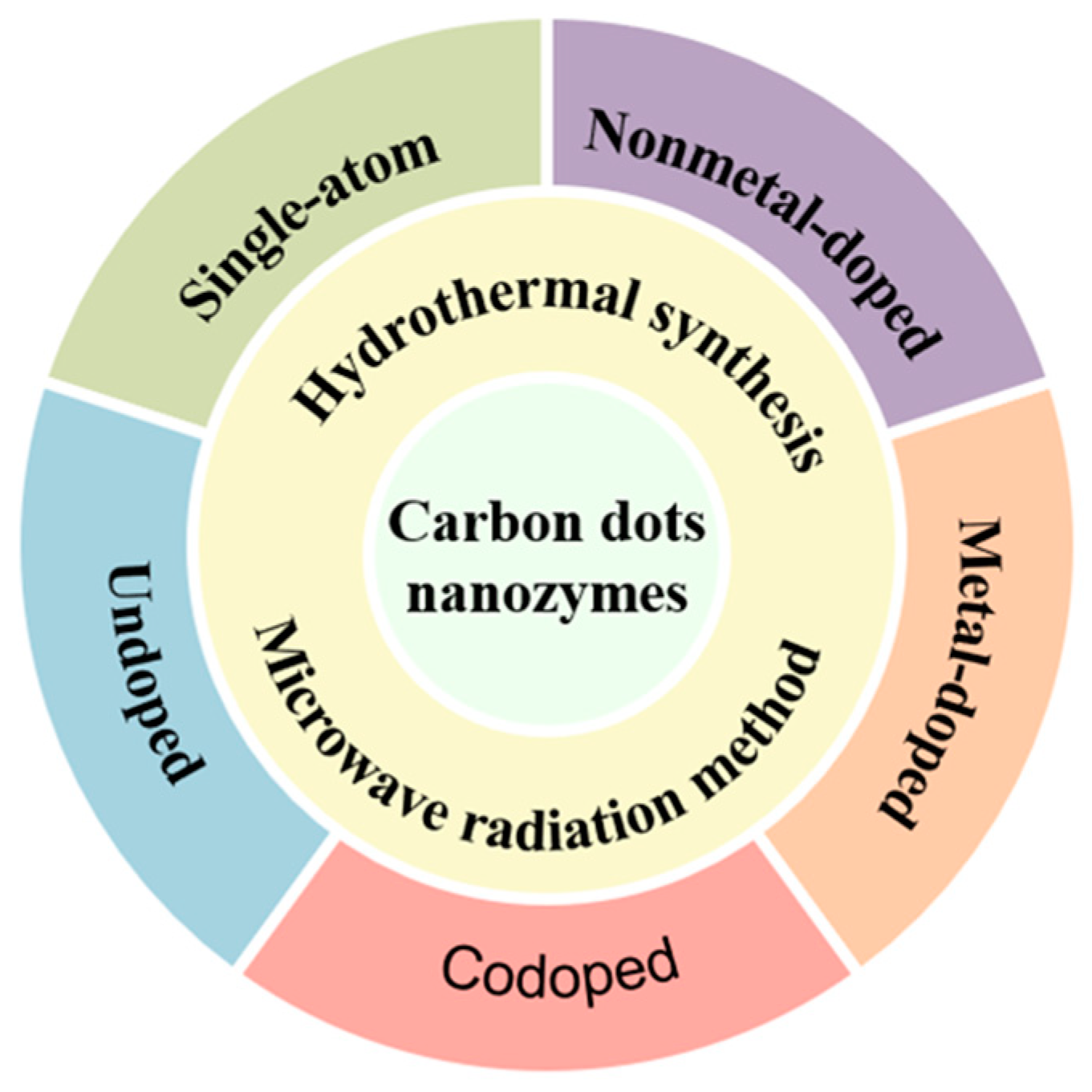
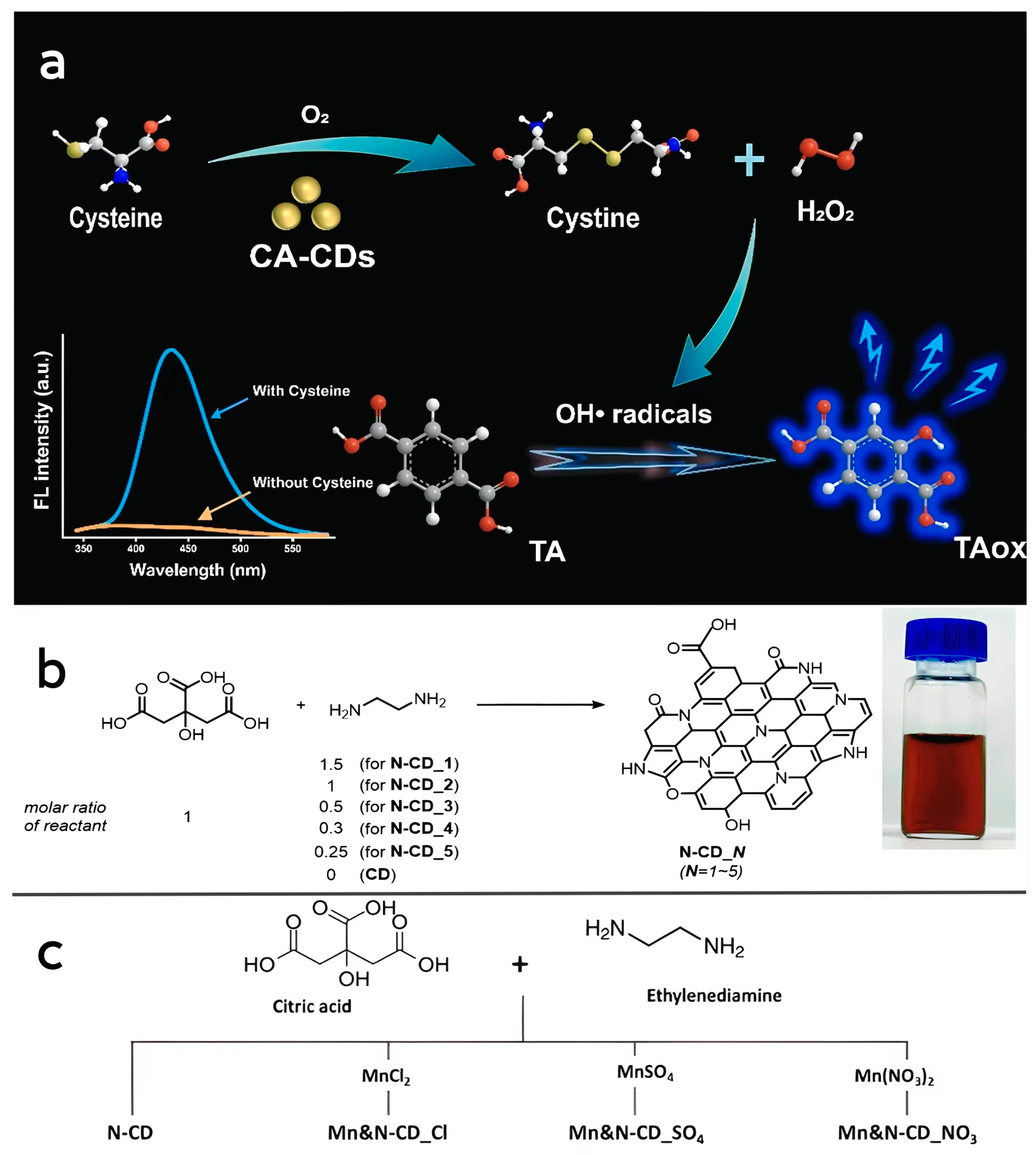
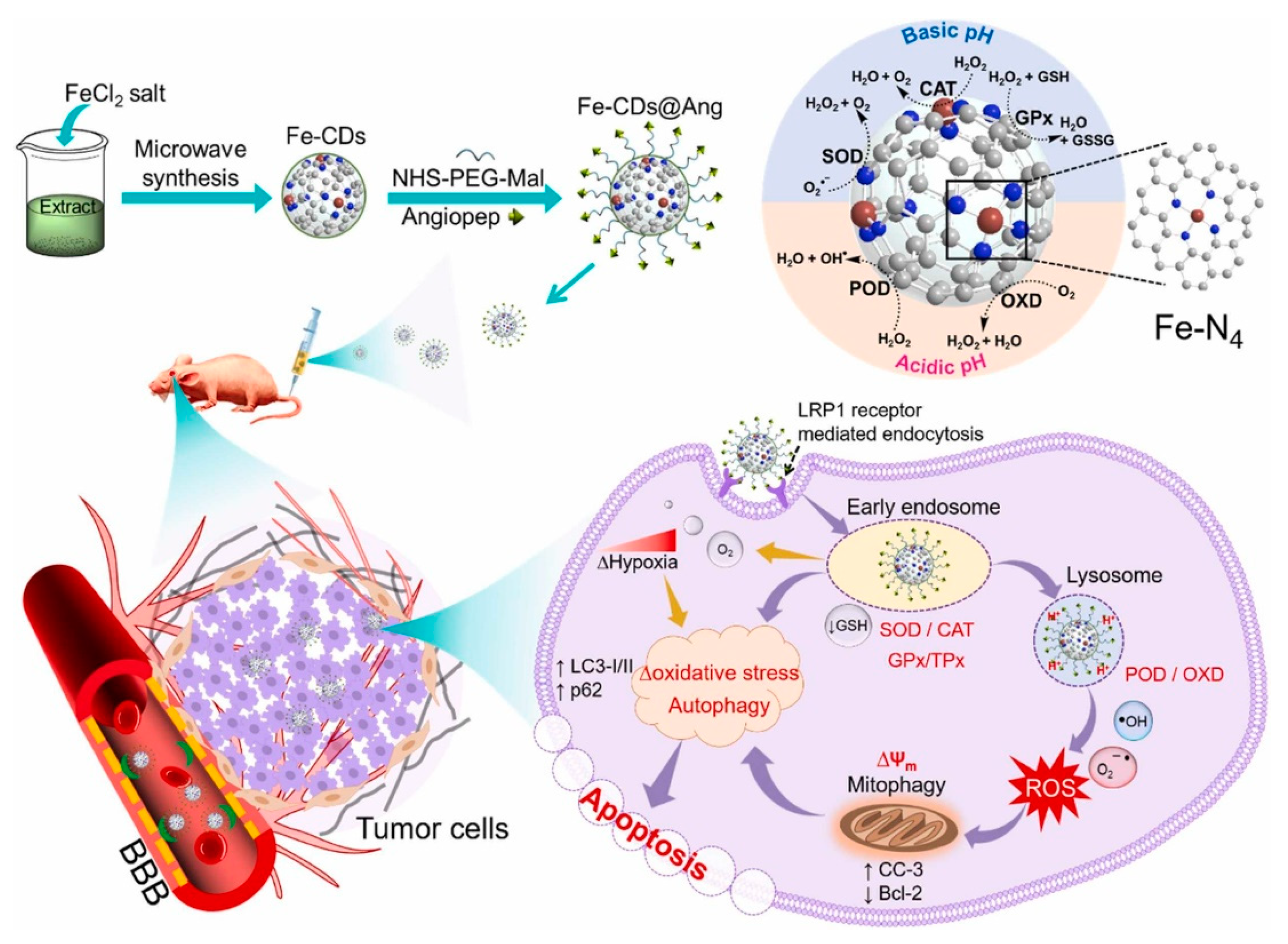
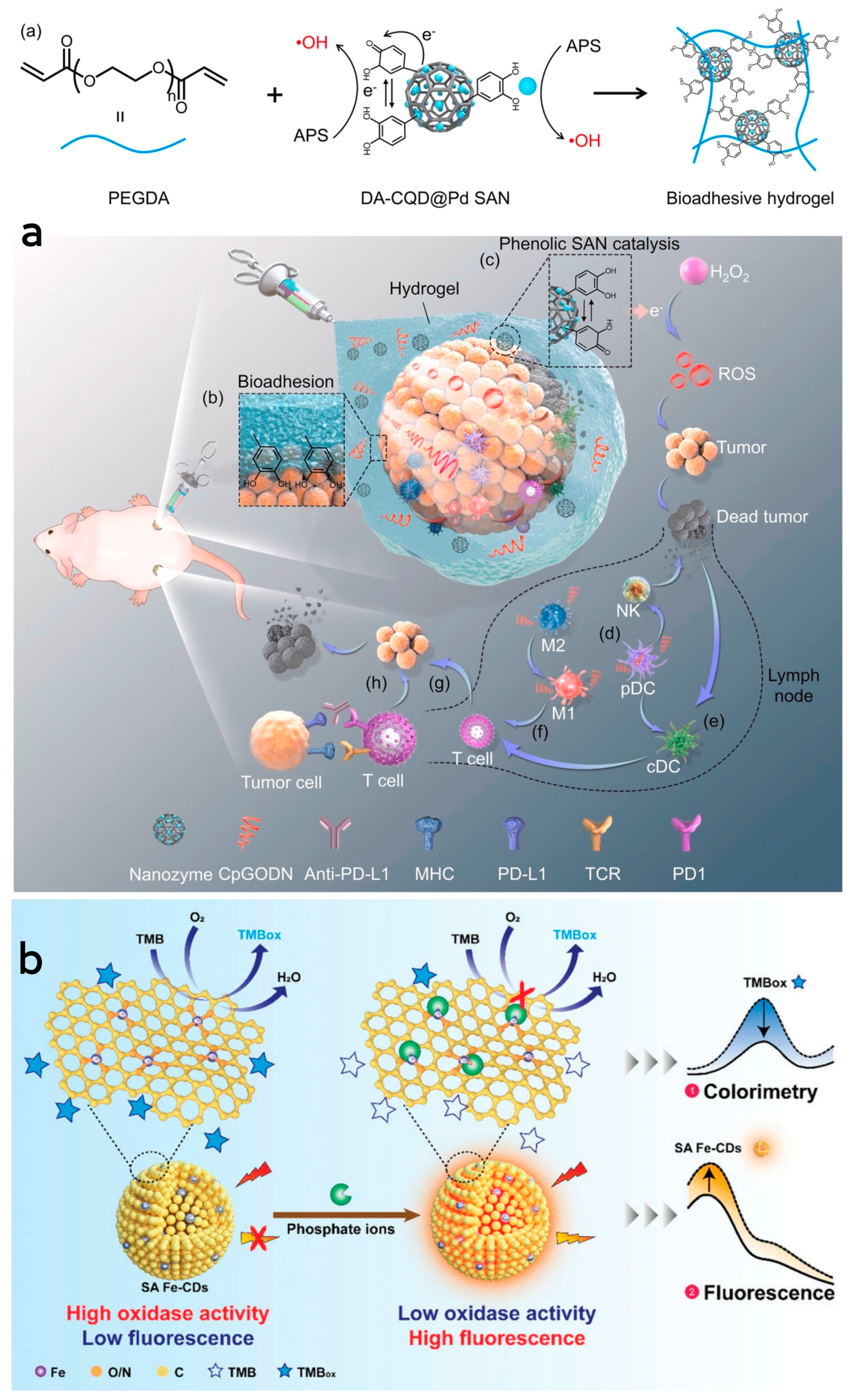
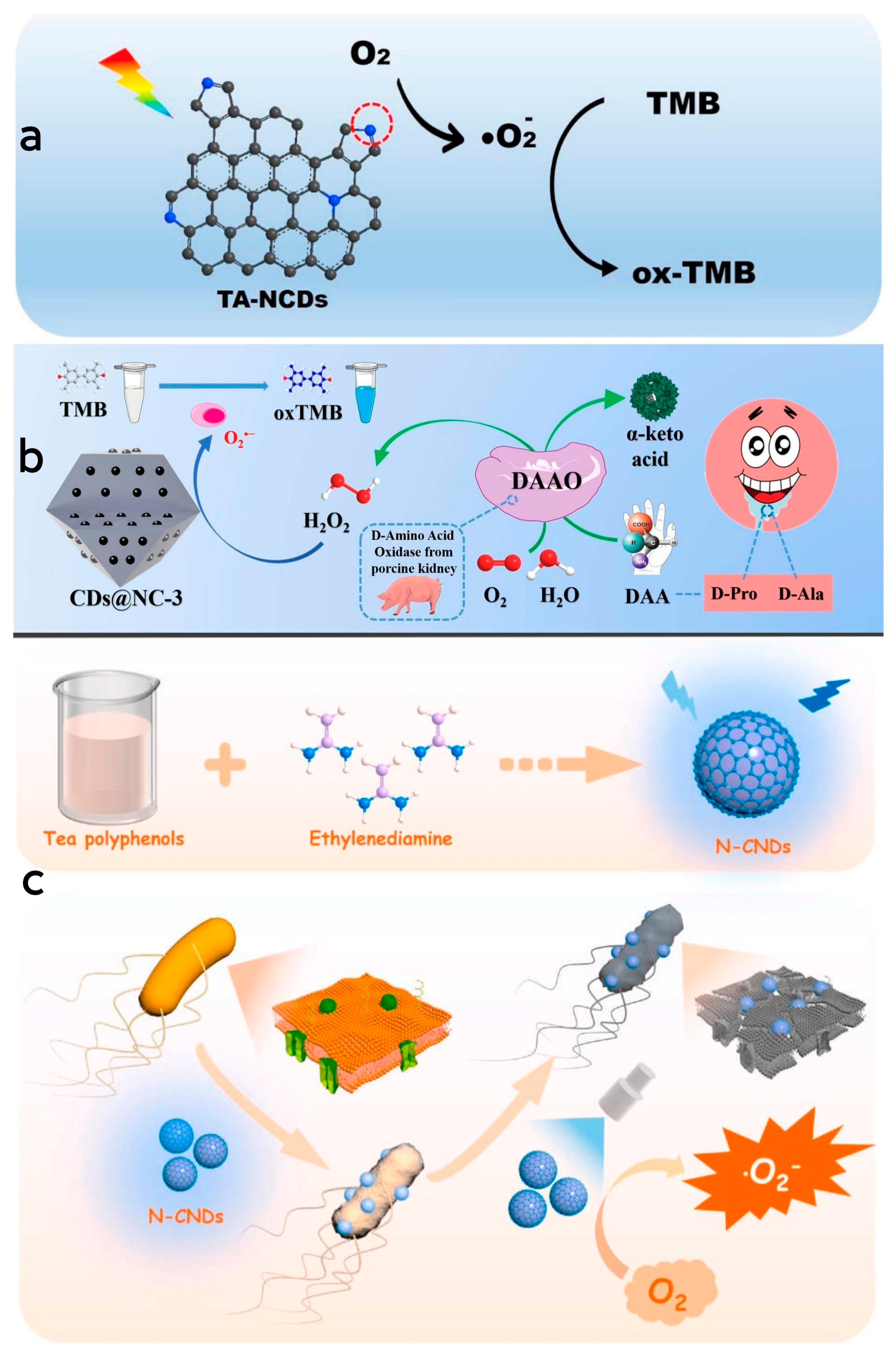
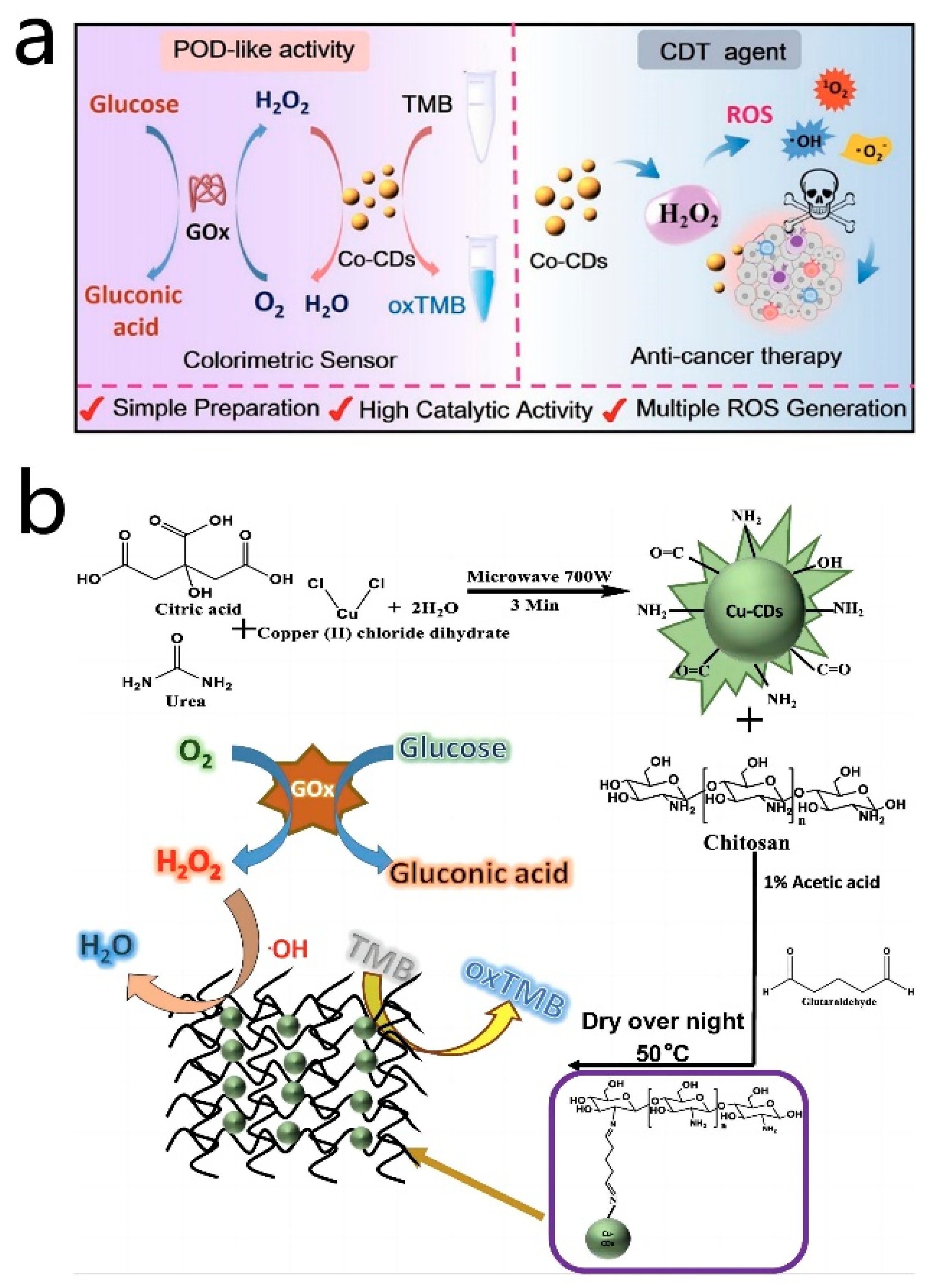
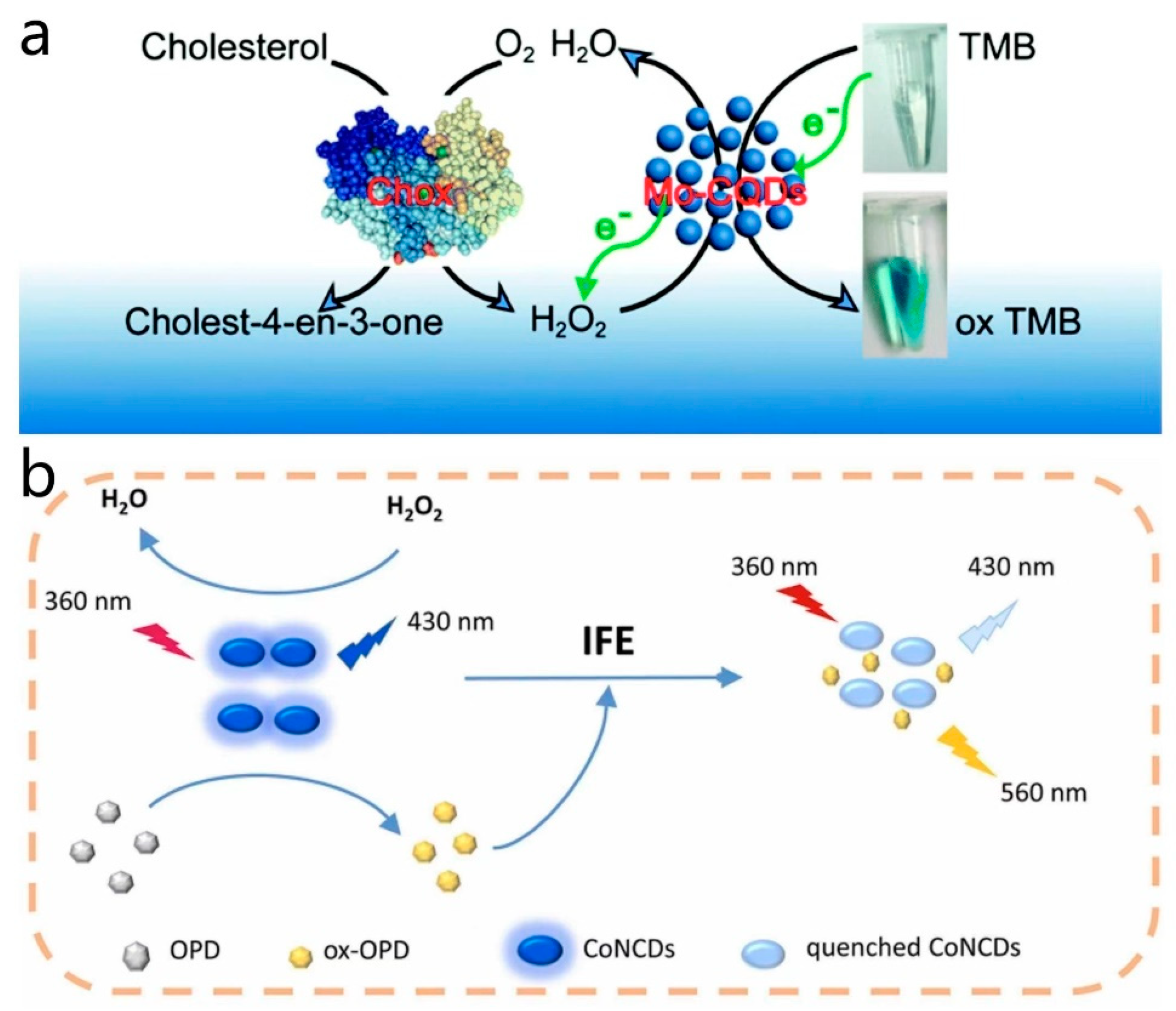
| Preparation Method | CDs | Precursor Material | Reaction Condition | Enzyme-like Activity | Applications | Ref. |
|---|---|---|---|---|---|---|
| Hydrothermal synthesis | CDs | Citric acid (CA), Ehylenediamine (EDA) | 200 °C, 8 h | OXD-like, POD-like | Photodynamic therapy | [62] |
| N-CDs | Valine | 200 °C, 12 h | POD-like | / | [63] | |
| N-CDs | CA, EDA | 200 °C, 1 h | POD-like | Optical probe | [64] | |
| N-CDs | Tea polyphenols, EDA | 200 °C, 10 h | OXD-like | Antibacterial | [65] | |
| N-CDs | Tartaric acid, 3-aminophenol | 160 °C, 12 h | OXD-like | Tumor therapy | [66] | |
| Fe-CDs | NaFeEDTA | 350 °C, 2 h | POD-like | Antibacterial | [67] | |
| Mn-CDs | MnCl2·4H2O, CA, EDA | 180 °C, 10 h | OXD-like | Colorimetric detection | [68] | |
| Co-CDs | Vitamin B12(VB12), CA | 180 °C, 3 h | POD-like | Biosensor and Anticancer | [69] | |
| Mo-CDs | (NH4)6Mo7O24·4H2O, ascorbic acid(AA) | 200 °C, 12 h | POD-like | Colorimetric sensing | [70] | |
| Mo, S-CDs | Ethanol, MoS2 | 200 °C, 12 h | POD-like | Colorimetric sensing | [71] | |
| Cu, Cl-CDs | CA, CuCl2·2H2O, choline chloride, etc. | 180 °C, 6 h | OXD-like, POD-like | Colorimetric detection | [72] | |
| Cu, I-CDs | CuCl2, EDA, 3-Iodo-L-tyrosine | 180 °C, 8 h | POD-like | Antifungal | [73] | |
| N, Cl-CDs | 3-Iodo-L-tyrosine, Iopromide3,5-Diiodo-DL-tyrosine | 180 °C, 10 h | POD-like | Antifungal | [74] | |
| Fe, N-CDs | FeCl3·6H2O, Na2EDTA | 200 °C, 10 h | POD-like | Biosensor detection | [75] | |
| Fe, N-CDs | Fe(NO3)3·9H2O, Diethylenetriamine pentaacetic acid | 180 °C, 10 h | POD-like | Colorimetric detection | [76] | |
| Fe, N-CDs | CA, FeSO4·7H2O, p-phenylenediamine | 180 °C, 8 h | POD-like | Antibacterial | [52] | |
| Co, N-CDs | Co(NO3)2·6H2O, Na2EDTA | 300 °C, 2 h | POD-like | Biosensing and bioimaging | [77] | |
| Co, N-CDs | EDTA–Na, Co(NO3)2·6H2O | 300 °C, 2.5 h | OXD-like | Antibacterial treatment | [78] | |
| Fe, N, S-CDs | Sunset yellow, FeCl3 | 200 °C, 3 h | POD-like | Colorimetric detection | [79] | |
| Microwave radiation | CDs | CA, L-histidine | 700 W, 2 min | OXD-like | Photodynamic therapy | [37] |
| Fe-CDs | CA, FeCl2·4H2O | 700 W, 14 min | POD-like | Colorimetric detection | [51] | |
| Fe-CDs | Bougainvillea plant leaves, FeCl3 | 630 W | OXD-like, POD-like, SOD-like, catalase-like (CAT-like), glutathione peroxidase-like (GPx-like), thiol peroxidase-like (TPx-like) | Tumor therapy | [80] | |
| Cu-CDs | Cu(CH3COO)2·H2O, urea, CA | 220 °C, 10 min | POD-like | Colorimetric detection | [81] | |
| S, N-CDs | CA, thiourea | \ | OXD-like | Antibacterial | [82] |
Disclaimer/Publisher’s Note: The statements, opinions and data contained in all publications are solely those of the individual author(s) and contributor(s) and not of MDPI and/or the editor(s). MDPI and/or the editor(s) disclaim responsibility for any injury to people or property resulting from any ideas, methods, instructions or products referred to in the content. |
© 2024 by the authors. Licensee MDPI, Basel, Switzerland. This article is an open access article distributed under the terms and conditions of the Creative Commons Attribution (CC BY) license (https://creativecommons.org/licenses/by/4.0/).
Share and Cite
Kong, J.; Zhou, F. Preparation and Application of Carbon Dots Nanozymes. Antioxidants 2024, 13, 535. https://doi.org/10.3390/antiox13050535
Kong J, Zhou F. Preparation and Application of Carbon Dots Nanozymes. Antioxidants. 2024; 13(5):535. https://doi.org/10.3390/antiox13050535
Chicago/Turabian StyleKong, Jichuan, and Feng Zhou. 2024. "Preparation and Application of Carbon Dots Nanozymes" Antioxidants 13, no. 5: 535. https://doi.org/10.3390/antiox13050535
APA StyleKong, J., & Zhou, F. (2024). Preparation and Application of Carbon Dots Nanozymes. Antioxidants, 13(5), 535. https://doi.org/10.3390/antiox13050535






